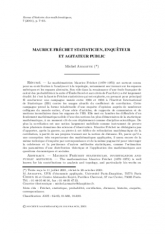Maurice Fréchet statisticien, enquêteur et agitateur public
Maurice Fréchet statistician, investigator and public agitator

- Année : 2001
- Fascicule : 1
- Tome : 7
- Format : Électronique
- Langue de l'ouvrage :
Français - Class. Math. : 62-03, 01A60, 01A90
- Pages : 7-65
- DOI : 10.24033/rhm.107
Le mathématicien Maurice Fréchet (1878–1973) est surtout connu pour sa contribution à l'analyse et à la topologie, notamment ses travaux sur les espaces métriques et les espaces abstraits. Son rôle dans la renaissance d'une école française de calcul des probabilités à la suite d'Émile Borel et aux côtés de Paul Lévy a été largement étudié. Ici c'est la facette Fréchet statisticien qui est explorée, en prenant pour principal fil conducteur une campagne menée entre 1934 et 1936 à l'Institut International de Statistique (IIS) contre les usages abusifs du coefficient de corrélation. Cette campagne prend la forme inhabituelle d'une enquête d'opinion auprès de nombreux collègues du monde entier, d'une série d'articles, de rapports de commission et de motions incendiaires dans les organes de l'IIS. Elle met en lumière les difficultés d'un fondement mathématique solide d'une des notions les plus élémentaires de la statistique mathématique, à un moment clé de son déploiement comme discipline scientifique. De plus la corrélation est une notion largement mobilisée comme instrument de preuve dans plusieurs domaines des sciences d'observation. Maurice Fréchet ne dédaignera pas d'apporter, après la guerre, sa pierre à cet édifice de refondation mathématique de la corrélation, à partir de ses propres travaux sur la notion de distance. Et, parce qu'il a une conception très respectueuse des mathématiques appliquées, il usera encore de la même technique d'enquête par correspondance et de la même pugnacité pour interroger la cohérence et la pertinence d'autres méthodes statistiques, comme l'estimation des paramètres d'une distribution théorique et l'application des mathématiques aux questions économiques et sociales.
Fréchet, statistique, probabilité, corrélation, distance, histoire, enquête, correspondance
